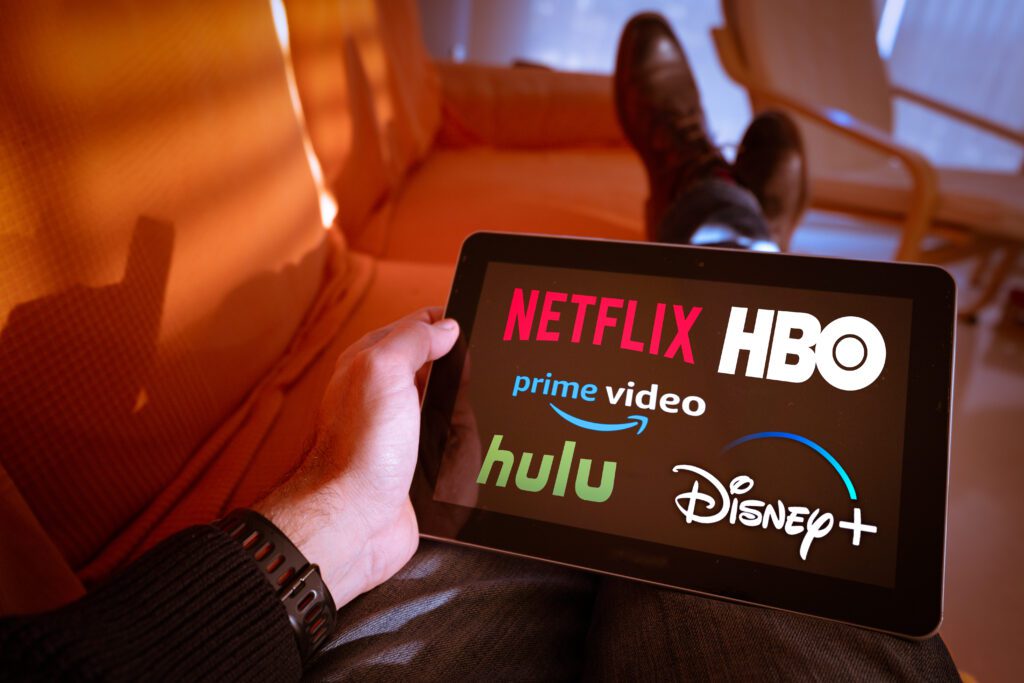
Why Streaming Advertising is the Future of Marketing

Netflix, Hulu, and HBO Max – streaming services are taking over how everyday people watch TV and movies. Long gone are the days of traditional television; it is now replaced with immediate full-season releases, lower prices, and consistent access (we can watch our shows on our phones, laptops, and actual TV).
Streaming through connected TV (also known as CTV) has become one of the most popular mediums for entertainment today. While convenient for the person watching, it also presents a unique experience for advertisers. This experience? Creating advertising for millions of people who have ditched traditional TV and opted for streaming.
So how many people are advertisers really going to reach? Spoiler? It’s a LOT! (source)
- An estimated 5.2 million households intended to end their cable subscriptions by the end of 2021.
- An estimated 4.9 million people will cut the cord in 2022.
- Cable providers have lost approximately 25 million subscribers since 2012.
There are so many benefits to brands advertising on streaming platforms, but before we get too ahead of ourselves, let’s first talk about what streaming advertising is and how it differs from traditional advertising.
Table of Contents
- What is Streaming Advertising?
- How is it Different from Traditional Advertising?
- 3 Benefits to Running Ads on Streaming Services
- Introducing Streaming Advertising into your Business
- Final Recap
- Get in Touch
What is Streaming Advertising?
The title is in the name – streaming advertising is advertising that runs within TV content before or during the content through an Internet-connected device.
One of the first streaming channels was Netflix. While they do not support streaming advertising, Netflix’s popularity inspired other businesses to dip into the streaming world – like Disney, Youtube, and Amazon!
Many of these newer platforms have tiered subscriptions, meaning there is the option to use the platform at a lower cost with ads or avoid ads altogether and choose a more expensive subscription. For example, Hulu has four different subscription options, with the lowest being $6.99/month, and gives access to its streaming library with ad breaks. But they can upgrade their subscription to $12.99/month and remove the ad breaks while still having access to its streaming library.
Keep in mind many users of streaming services are cord-cutters meaning they ditched cable and opted for streaming services to avoid a big monthly cable bill. People are selective about the streaming device they use. The Hub Research Institute found that “two-thirds (67 percent) said they would choose ad-supported TV over an ad-free subscription.”
So, for some people having a cheaper subscription tier with ad breaks is more appealing than a more expensive tier with no ad breaks.

How is it Different from Traditional Advertising?
While streaming and traditional TV advertising sound very similar, there are two key differences.
- TV advertising is purchased on broadcast media (like TV) and run during a segmented time. Streaming advertising is delivered through mass media to a targeted audience (leading us to our second point)
- Targeting. Streaming ads are very targeted because streaming services have more information on their users. Versus TV ads run to anyone watching that broadcast during their segmented time.
3 Benefits to Running Ads on Streaming Services
The benefits of streaming advertising are endless because streaming is not stagnant. We’re still so new to the streaming world, and there are changes and updates every single day.
Here are three benefits to running ads on streaming services today:
Targeted
As society shifts to using streaming platforms and streaming platforms support advertising – these advertisers can continue to reach and engage with the audience they lost on traditional media. Additionally, because streaming is a digital-first platform, it also stores a lot of data on its users.
Streaming services have more access to their user base compared to traditional TV advertising. So when you advertise, you can not only narrow your audience down by demographics but also age, gender, interests, etc.
Streaming advertising provides so much online data about users that advertisers can align their ad content to target their audience and accurately measure its success.
Ultimately leading to:
- More sales for the advertiser, hopefully leading to more ad spending. Relevant ads for the viewer, hopefully leading to a longer watch time. And, of course, a happier streaming platform because their users and advertisers are happy.
With the shift to TV streaming, advertisers have an opportunity to reach and engage their customers on mediums like never before.
Want to learn more about targeting? Reference these blogs:
- Marketing Hack – Three Ways to Research Your Ideal Audience and What you Should be Looking for
- How Competitor Research and Analysis can Help Your Business
- Do you Really Know your Audience, or are you Just Guessing?
Interactive Ads
A new advertising option that streaming platforms are testing is interactive ads. A few examples of interactive advertising are playable games, choosing your adventure, or surveys.
Interactive ads are a great option because they encourage viewers to reach for the remote, react to your ad, and increase engagement. Taking the time to play a game or answer the question shows that your audience is engaged in what they are watching and the content you, the advertiser, are sharing.
From there, advertisers can review their metrics to see how an interactive ad performs and whether their audience reacts. If you notice that your audience isn’t engaging or you feel that your ad is not performing properly, you can then refine your targeting or change your ad.
Interactive ads are still new to streaming, but advertisers who implement them can stay ahead of the curve and are more likely to be remembered the next time someone needs a product or service similar to yours.
Cost Effective
Next, streaming ads are more cost-effective than their traditional counterparts. So not only are you reaching an audience that migrated from conventional TV, but you are spending less money doing it.
When a business wants to advertise on TV, it usually requires a bigger budget and upfront commitment – whether that be committing to 1 month, 2 months, 3 months, 6 months, etc. This budget and time commitment limit who can take advantage of TV advertising.
Comparatively, streaming ads can be purchased month-by-month and spread out through multiple campaigns. This way, businesses can choose the campaign type that best fits a business’s needs in achieving its goals.
Streaming ads are targeted, so a business’s advertising spending goes further.
As mentioned, a huge benefit to streaming ads is their targeting capabilities. Targeting and cost go hand in hand because you can be more intentional about your budget and how you use it. Your advertising dollar goes further when invested in streaming ads.
With traditional advertising, businesses buy ad space for a certain period of time and hope that they reach the right audience, whereas streaming allows you to include your targeting. As a result, it’s much more cost-effective because you know your money will reach a relevant audience.

Introducing Streaming Advertising into your Business
Streaming advertising has endless benefits, and because it’s still new to the advertising world, it’s still changing and transforming.
If you’re looking to integrate streaming advertising into your current advertising strategy and are unsure where to start – we promise it’s easier than it sounds!
First, reflect on your budget. For example, how much do you spend on advertising overall? How much do you spend on digital advertising? What about traditional advertising? Is there wiggle room in your budget, or would you have to reallocate funds?
As mentioned, streaming advertising is more cost-efficient than traditional TV advertising, so look at that budget as your baseline, understanding that you’ll spend less.
Next, look at your audience and the targeting you use for your digital advertising. You can keep that targeting, but refer back to it consistently to ensure your audience is responding. Once you start advertising and notice that maybe they’re not responding how you anticipated, take this as a sign to reevaluate.
Finally, review the streaming platforms available to you and which ones are in your budget. Right now, there are a few different platforms that support ads. That could be Hulu, Peacock, Disney+, HBO Max, and more. Review that platform’s audience and any additional features they offer to ensure that your streaming platform best suits your goals.
Streaming advertising is a bit of a hybrid between traditional and digital advertising so keep that in mind as you finalize your targeting, budget, and platform. Streaming is the future of TV. As cable costs rise, more people are looking to cut the cord and switch to streaming platforms that are hosted online.
Due to its popularity, usability, and large audience, advertisers can share their products or services with an audience they no longer have access to on traditional TV.
The best thing you can do for your business is to start – take your budget, your target audience, and your messaging and see how streaming advertising can transform your business.
Here are a few best practices for streaming advertisements
- Be direct and introduce your brand within the first few seconds.
- Create an effective CTA. Streaming ads are not clickable, so you need to find other ways to bring in your audience.
- Ensure your ad is scalable. You can stream content on your phone, tablet, TV, etc. you want your content to work on each device.
People who watch content on streaming platforms typically do so intentionally, so connecting with them in that space is memorable. In addition, because the ads on streaming platforms are shorter, there’s less risk of losing your audience’s attention.
Final Recap
Let’s quickly review what we went over. To summarize, streaming advertising is advertising that runs within TV content through an internet-connected device. It runs before or during the tv show, movie, etc. Streaming advertising differs from traditional advertising because it’s targeted and delivered through mass media. Traditional TV is broadcasted to whoever is watching the TV segment during that time.
Streaming advertising is a hybrid between traditional advertising and digital advertising – the biggest example of this is that streaming advertising runs based on impressions, and the advertiser can choose how many impressions they want to run that month. However, traditional TV requires a larger financial and time commitment. The advertiser needs to commit to 3 months, 6 months, 9 months, etc., and a much higher budget than streaming.
The benefits of streaming advertising are endless because it’s still evolving. Here are a few of its current benefits:
- Targeted
- Cost-effective
- Interactive
In addition, streaming ads appear alongside quality content. Unlike traditional media, where you pick a network and a time slot, streaming ads are targeted and run based on impression. So your ad will run alongside content your audience is actively watching and interested in.
This shift to streaming advertising has provided brands the opportunity to engage with consumers in a way they never could before. Because you can stream content on your phone, tablet, laptop, TV – basically anything that can connect to the internet- brands can also connect with their audience on all those devices.
It’s a powerful medium. It is incredibly targeted and accessible.

Get in Touch
Did you know that 74% of 18-34-year-olds in the U.S have either never had cable, already cut the cord, or plan to shortly? We’re in the generation of “cord-cutters,” where people are replacing their traditional cable subscriptions with more cost-effective online streaming alternatives.
Streaming advertising is the future of marketing, and it’s going to get here faster than you think. So many customers are shifting from cable and radio services and opting for streaming services like Hulu and Spotify.
Businesses – take this as an opportunity to get ahead of the curve and continue connecting with your audience. Streaming platforms are making TV advertising more accessible for a wider range of brands like local cleaners, plumbers, home maintenance businesses, etc. who may not have been able to afford it before.
Whether or not you currently run ads on streaming platforms or you’re still thinking about it, join the conversation on LinkedIn. If you’re ready to dive right in and get started, schedule a discovery call so we can discuss your business’s needs, goals, and any challenges. We’d love to partner with you.


